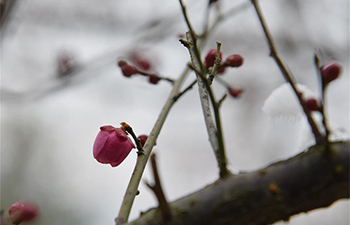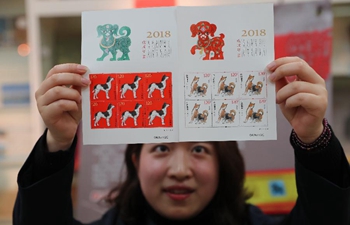NAIROBI, Jan. 6 (Xinhua) -- After years of struggling growing various crops in vain due to low rainfall, farmers in semi-arid areas in Kenya have finally found a crop that is putting money in their pockets.
The crop is not only drought-tolerant but is highly valued both in Kenya and in the export market especially in Asia, making the farmers reap profits amid the negative effects of climate change, which has hit hard arid areas.
The green gram is also known as the mung bean, a small round bean similiar in shape to the field pea. The crop requires low rainfall hence performs well in semi-arid areas, is resistant to many pests and goes for up to 1.5 U.S. dollars a kilogram in the Kenyan market.
Sammy Mutunga, a farmer in the dry Kitui County, eastern Kenya, is among those who have embraced the crop reaping big from his once unproductive land.
Mutunga grows green grams on two acres and this is his third season, having started the farming in 2016.
"I was among the first people who embraced the crop when a non-state organization came in this area to promote it. They told us that it would perform better than the maize we were all struggling to grow. At first we doubted because they were selling the seeds but I gave it a try, starting with quarter acre," he recounted Friday.
The crop did unexpectedly well, said Mutunga, noting that he harvested a 90kg bag of green grams from the quarter acre.
"I was extremely happy. I could not believe that from a quarter acre, I would get a bag of green grams yet my two acres of maize only offered less than 10 bags," he said.
He sold the produce at 0.8 dollars a kilogram, earning some 60 dollars, which he had not even anticipated.
Since then, Mutunga and dozens of other farmers in the county have embraced the crop, ditching maize and others that were not performing well.
"I grow the crop on five acres after stopping the farming of cowpeas which I had done for years. This is my second season and I must say things are good. Last season, I harvested 20 bags (about 90kg) of green grams and sold a kilo at 1 dollar, earning some 1,747 dollars, money that I have never reaped before," said Elizabeth Muli, a farmer in Machakos County.
"I normally plant seeds in a spacing of 10cm from one crop to another and 60cm between the rows. One uses 4kg on an acre and plant with some DAP fertiliser," she offered.
Green grams take three months to mature and the pods are harvested just like beans, dried, threshed and winnowed.
"An acre produces at least 4 bags and one spends some 180 dollars per acre to grow the crop. Which means if they sell a kilo at 1 dollar, they end up with some 180 dollars profit. This is good money," said Muli.
Several kilometers away in Tharaka-Nithi County, another dry region in central Kenya, farmers growing the crop are exporting it to India, China, Saudi Arabia and Pakistan.
The farmers export the crop through an agent and in 2016, they earned some 194,174 dollars from export to Dubai.
"Green gram is ideal for dry areas because it requires little rainfall. Rains in arid areas last only about three weeks, which are enough for the crop to grow until they have four to six leaves and are ready for first weeding," said Bernard Moina, an agricultural officer.
He noted that green grams are a lucrative crop since in supermarkets, a kilo goes for up to 1.8 dollars while farmers sell on the farm for at least 1 dollar.
Kenya Red Cross Society, which has partnered with county governments in eastern Kenya to promote the crop, noted that its aim is to make it the cash crop. Secretary-general Abbas Gulet said the agency has set aside some 5 million dollars to buy produce from farmers mainly in Kitui to save them from exploitation by middlemen, adding the crop would save residents from perennial hunger that has dogged the region for years.

















